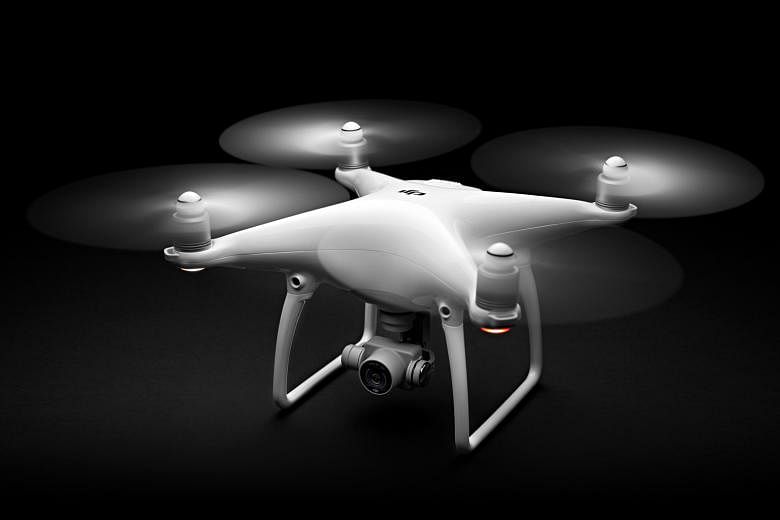With the Phantom 4, Shenzhen-based DJI has built a drone that is simple enough to ease newbies into the world of flying, yet sophisticated enough for professional use.
While the last-generation Phantom 3 came in standard, 4K, advanced and professional variants, there is only one model of Phantom 4, and it covers all the bases.
Newbie-friendly intelligent features? Check. 4K camera with slow-mo recording? Check. A frightening top speed of 72kmh? Check.
In short, there is currently nothing else on the market that can go toe-to-toe with the Phantom 4 as an accessible yet advanced prosumer-level drone. The Phantom 4 looks very similar to the Phantom 3, and from a distance you would be hard-pressed to tell the two apart.
The Phantom 4 is sleeker and cleaner, with slimmer arms, although its weight has gone up marginally from 1,280g to 1,380g. The underside where the camera is housed also looks a lot less fussy.

-
TECH SPECS
-
PRICE: $2,090; $2,210 with one extra battery and $2,335 with two extra batteries, from www.singahobby.com
CAMERA: 12-megapixel, with 4K video at 30fps and Full HD video at 120 fps
LENS: FOV 94° 20 mm (35 mm format equivalent), f/2.8
-
RATING
-
FEATURES: 5/5
DESIGN: 5/5
PERFORMANCE: 5/5
BATTERY LIFE: 4/5
VALUE FOR MONEY: 4/5
OVERALL: 5/5
The ease of use of the Phantom 4 has also been bumped up. The Phantom 3 was already simple enough to fly out of the box, but the Phantom 4 takes this one step further with a handful of intelligent features.
TapFly is a feature that allows users to tap on an area on the screen and the drone will head towards it, avoiding obstacles on the way. The Phantom 4 also has a nifty obstacle sensing system so that it either stops when confronted with an obstacle, or looks for a way to fly over it. When I tried it, it worked even with "holey" obstacles like wire fences.
However, as the Phantom 4 uses its camera to detect obstacles, users will still need to be careful when flying the drone sideways or through corridors, as the camera faces only one direction at a time.
My favourite intelligent feature is ActiveTrack, in which the drone automatically follows an on-screen object, such as a person. Conventionally, with most other drones, such tracking had to be done by hand and by an experienced pilot in order to capture smooth, cinematic video. With ActiveTrack, it is possible for even first-time users to capture steady tracking footage, and to even dramatically pan 360 degrees around a moving object.
The 4K camera on the Phantom 4 is largely the same as the one on the Phantom 3, although it is now capable of recording in slow-mo at Full HD at up to 120 frames per second (fps).
While the intelligent features on the Phantom 4 are very helpful, taking over manual control is a cinch. During my time with the drone, it managed to stay stable despite reasonably strong winds.
DJI has also upped the maximum speed of the drone from 16m/s (57kmh) to 20m/s (72kmh), which should be more than enough for most filming purposes. It can do all of this for up to 28 minutes per full battery, a slight improvement over the 23 minutes of the Phantom 3.


